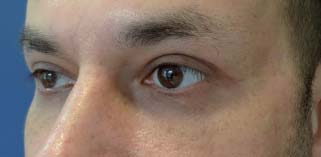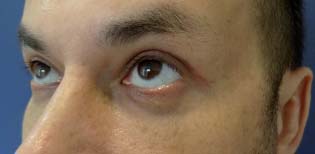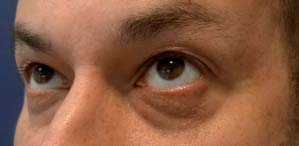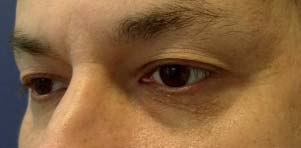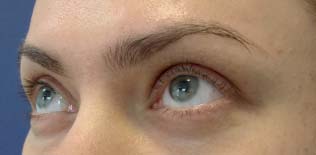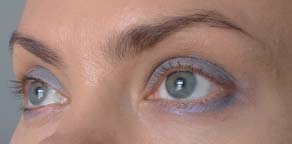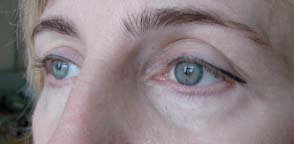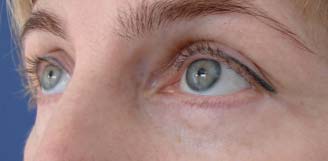Lipofilling is a procedure for volumizing tissues in order to restore their volumes using autotransplantation of fat cells. We will tell you from a scientific and practical point of view about the effectiveness of using this technique for correcting changes in the periorbital zone.
Vladimir Pirus , Master of Medicine, plastic surgeon, full member of VAPREH, APAM (Ukraine)

The areas of application of lipofilling are very extensive, for example: correction of the volume of the middle part of the face, periorbital zone, oval of the face, volume of the lips, nasolabial folds, correction of the contours and volume of the chest, buttocks, legs. It can also be used as a reconstructive procedure for the treatment of scar deformities and contractures, atrophies of various origins and asymmetry.
Principles of material sampling
The lipofilling procedure is relatively simple, however, it requires certain skills from the practicing surgeon. Here, dexterity and sleight of hand are not so much valued as accuracy, eye, and spatial thinking.
At the first stage of the procedure, the donor area is determined from where the fat will be extracted. Usually, the places where the most persistent deposits of fatty tissue accumulate are chosen - the areas of the so-called fat traps. It is believed that this is where fat cells are most resistant to stress. There are quite a lot of stress factors for living cells during autolipofilling, from fat collection to its processing by centrifugation and further administration. At all three stages, fat cells experience enormous stress, which affects their survival rate. Therefore, it is considered quite reasonable to choose areas where the mentioned fat traps exist.
Through thin 2–3 mm punctures, fat cells are aspirated in the required volume. It is very important that this procedure is performed delicately, without creating new irregularities or deformations.
Then the fat cells are processed, which makes it possible to obtain pure fat without the admixture of blood and infiltration solution, cells. The most popular purification method is centrifugation, although some experts prefer to use fat settling or filtration. There are many opinions on this matter, and they all have both positive and negative sides. Be that as it may, everyone comes from their own experience and observations.
Methods for injecting fat cells
Microlipografting
After treatment in the operating room, fat cells can be immediately introduced into the area of needed correction. Typically, thin cannulas with an internal lumen of 1.2–0.7 mm are used for this purpose.
It is very important to inject fat in such a way as to evenly fill the atrophy space, and it is equally important to inject it into different layers. The smaller and thinner the fat grafts, the more blood vessels around them that can provide them with blood, and therefore oxygen. The better blood supply fat cells receive, the better they take root.
Nanolipofilling
Recently, nanolipofilling has become especially popular. This is a special procedure that uses emulsified fat containing a large number of regenerative cellular factors. As a result of the procedure, the skin has a stimulating regenerative effect, improving its appearance and condition.
Nanolipofilling can be used in a complex of rejuvenating procedures for the area of the hands, décolleté, and periorbital area. The method involves the use of finely dispersed emulsified fat, which acquires a homogeneous paste-like consistency. In this case, it is physically possible to inject fat through insulin needles. And what is most interesting, intradermal. The main goal is to use regenerative cell factors rather than whole fat cells.
Photo 1: Before Photo 1: After
Photo 2: Before Photo 2: After
Lipofilling in complex correction algorithms
Lipofilling is an excellent addition to operations such as blepharoplasty, facelift, and correction of atrophic changes in the mammary glands during re-endoprosthetics. In many cases, lipofilling gives excellent results as an independent procedure in patients with minor age-related changes.
Since some fat cells die during lipofilling (30–40%), quite often the patient is prescribed a repeat corrective procedure to achieve an optimal result. It is believed that the best period for such correction is periods of three months or more.
Before each upcoming procedure, you should always evaluate the condition of the tissues. If there are any processes of inflammation or infiltration, the procedure should be postponed until the symptoms disappear.
Precautionary measures
The main symptoms, such as swelling and minor bruises, disappear after about 10–14 days.
During this period it is strictly prohibited:
- do an intense massage in the lipofilling area;
- apply warming procedures (including visiting a sauna, bathhouse);
- carry out air travel within 5–7 days;
- drink strong alcohol, eat spicy foods with a lot of salt;
- smoking, as this can significantly impair the survival of fat cells due to spasm of peripheral capillaries;
- use local cold compresses and postoperative compression bandages and underwear, as they worsen the survival process of fat cells.
Correction of “dark circles” around the eyes using lipofilling
Some of my patients complain of having “bruises” and “dark circles” under their eyes. The presence of such problems, as a rule, creates a clear, clear imprint of fatigue on the face, and, unfortunately, cosmetics cannot always cope with them, since the problem can sometimes lie in the plane of volume deficiency, tissue thinning, and age-related atrophy. Moreover, very often such age-related changes manifest themselves in fairly young patients.
As a rule, cosmetic products can cope with the problem of pigmentation and blueness caused by the transillumination of the capillary pattern through the thin dermis of the lower eyelid.
There are several reasons for the existence of “circles” or “bruises”:
- Reason one: deepening in the area of the nasolacrimal groove, the edges of the orbit.
Usually this problem is solved by correcting the missing volume, that is, directly lipofilling. As an alternative, fillers can be used successfully.
- Reason two: thin skin in the lower eyelid area, through which the vascular capillary pattern is visible.
At the same time, it is able to create the illusion of “bruises” under the eyes. In this case, nanolipofilling can be used, which can thicken the dermis and subcutaneous layer in the lower eyelid area and thus reduce the optical permeability of the skin. Cosmetics will help disguise the problem.
- Reason three: genetically determined or acquired pigmentation.
The reason actually lies in the presence of pigment cells - melanocytes - in large numbers in the dermis of the lower eyelid. As a rule, this problem is corrected with the help of whitening creams and peelings, although, I must admit, this is not always effective, since cosmetics hardly mask the existing problem.
Photo 3: Before Photo 3: After
Photo 4: Before Photo 4: After
Indications for lipofilling in the lower eyelid area
Sometimes there are indications for lipofilling as an isolated procedure. Most often, patients who do not have so-called fatty hernias and without significant excess skin fall into this category. This category of patients is ideal for lipofilling of the lower edge of the orbit.
There is another category, which includes patients with more pronounced age-related changes, which, of course, require more serious surgical intervention, supplemented by lipofilling. An example of such surgery is blepharoplasty and midface lift. Sometimes it seems that the problem is obvious and it is enough to tighten the sagging tissues. But in such situations, behind the apparent obviousness, there is a related problem - a lack of volume. And the task of each surgeon is to promptly recognize and correctly eliminate the accompanying problem, which will significantly complement the good result of blepharoplasty, midface lift or facelift in general.
As a rule, the problem of volume loss in these cases always exists. And if it is not resolved, the result of the main procedure may not be ideal. Restoring lost volume is perhaps one of the important key points of anti-aging procedures. Volume restoration (like no other procedure) can give such a harmonious and pronounced effect. Of course, provided that all proportions are met.
Conclusion
The only alternative that can be considered in relation to lipofilling is the use of fillers, primarily hyaluronic acid fillers, which can maintain volume for quite a long time. On average, they provide a year and a half of stable effect.
However, this method has its drawbacks. Thus, hyaluronic acid is subject to biodegradation, the formation of edema is possible due to the hydrophilicity of the gel, as well as the formation of heliomas, granulomas and migration. Still, unlike fat, it is a foreign substance, even of biological origin, with high rates of inertia on the part of the human immune system.
Transplantation of the patient's own fat is ideal from the point of view of tissue physiology and anatomy. This technique has a great future and, perhaps, great prospects for application. Starting from basic work with the reconstruction of lost volume and ending with regenerative medicine.
First published in Les Nouvelles Esthetiques 2015/№2
